An experimental pig model with outer retinal degeneration induced by temporary intravitreal loading of N-methyl-N-nitrosourea during vitrectomy
- PMID: 33420119
- PMCID: PMC7794530
- DOI: 10.1038/s41598-020-79437-1
An experimental pig model with outer retinal degeneration induced by temporary intravitreal loading of N-methyl-N-nitrosourea during vitrectomy
Abstract
We aimed to develop an outer retinal degeneration pig model induced by temporary intravitreal loading of N-methyl-N-nitrosourea (MNU) during vitrectomy. In a preliminary experiment involving 5 mini-pig cases to determine the appropriate concentration of MNU, the vitreous cavity of each eye was filled with 4, 8, 10, 12, or 16 mg/mL MNU for 10 min, which was then replaced with a balanced salt solution. Multimodal examinations including spectral-domain optical coherence tomography (OCT) images and full-field electroretinography (ffERG) were obtained at baseline and week 2, week 6, and week 12. The retinal degeneration was classified according to the amplitudes of a dark adaptive (DA) 10.0 a-wave amplitude. The degree of moderate retinal degeneration was defined as DA 10.0 a-wave amplitude ≥ 10% and < 60% of baseline amplitude. The degree of severe degeneration was defined as DA 10.0 a-wave amplitude < 10% of baseline amplitude, noise, or flat signal. Hematoxylin and eosin staining and immunohistochemistry were performed at week 12. The main experiments were conducted first with 10 cases of 5 mg/mL and later with 13 cases of 10 mg/mL. In the preliminary experiment, degree of outer retinal degeneration increased with MNU concentration. Use of 4, 8, 10, 12, and 16 mg/mL MNU showed no, moderate, severe, severe, and atrophic changes, respectively. In the main experiments, there were 9 cases of moderate retinal degeneration and 1 case of severe degeneration in 5 mg/mL MNU group. Two cases of moderate degeneration and 11 of severe degeneration were recorded in 10 mg/mL group. Mean thickness of total retina, inner nuclear layer, and outer nuclear layer decreased at week 2 in both groups. The mean amplitudes on ffERG decreased at week 2. The ffERG and OCT findings did not change from week 2 to week 6 or week 12. The results of staining supported those of ffERG and OCT. Temporal MNU loading in a vitrectomized pig-eye model induced customized outer retinal degeneration with changing the concentration of MNU.
Conflict of interest statement
The authors declare no competing interests.
Figures
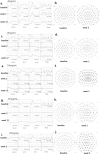

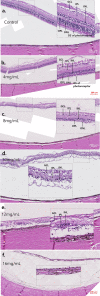

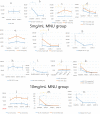
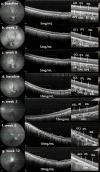

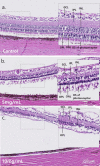
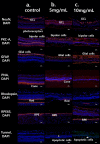

Similar articles
-
Photoreceptor degeneration by intravitreal injection of N-methyl-N-nitrosourea (MNU) in rabbits: a pilot study.Graefes Arch Clin Exp Ophthalmol. 2017 Feb;255(2):317-331. doi: 10.1007/s00417-016-3531-7. Epub 2016 Nov 19. Graefes Arch Clin Exp Ophthalmol. 2017. PMID: 27866331
-
Selective photoreceptor degeneration by intravitreal injection of N-methyl-N-nitrosourea.Invest Ophthalmol Vis Sci. 2014 Mar 20;55(3):1711-23. doi: 10.1167/iovs.13-13242. Invest Ophthalmol Vis Sci. 2014. PMID: 24550357
-
Outer retinal degeneration in a non-human primate model using temporary intravitreal tamponade with N-methyl-N-nitrosourea in cynomolgus monkeys.J Neural Eng. 2023 Jan 20;20(1). doi: 10.1088/1741-2552/acb085. J Neural Eng. 2023. PMID: 36603218
-
Intravitreous Delivery of Αb-Crystallin Ameliorates N-Methyl-N-Nitrosourea Induced Photoreceptor Degeneration in Mice: An in vivo and ex vivo Study.Cell Physiol Biochem. 2018;48(5):2147-2160. doi: 10.1159/000492557. Epub 2018 Aug 15. Cell Physiol Biochem. 2018. PMID: 30110696
-
[Characteristics of N-methyl-N-nitrosourea-induced retinal degeneration in animals and application for the therapy of human retinitis pigmentosa].Nippon Ganka Gakkai Zasshi. 2005 Jun;109(6):327-37. Nippon Ganka Gakkai Zasshi. 2005. PMID: 16047940 Review. Japanese.
Cited by
-
Endothelial cell heterogeneity and microglia regulons revealed by a pig cell landscape at single-cell level.Nat Commun. 2022 Jun 24;13(1):3620. doi: 10.1038/s41467-022-31388-z. Nat Commun. 2022. PMID: 35750885 Free PMC article.
-
Rapamycin Improved Retinal Function and Morphology in a Mouse Model of Retinal Degeneration.Front Neurosci. 2022 Feb 28;16:846584. doi: 10.3389/fnins.2022.846584. eCollection 2022. Front Neurosci. 2022. PMID: 35295093 Free PMC article.
-
Electrical response of retinal ganglion cells in an N-methyl-N-nitrosourea-induced retinal degeneration porcine model.Sci Rep. 2021 Dec 17;11(1):24135. doi: 10.1038/s41598-021-03439-w. Sci Rep. 2021. PMID: 34921172 Free PMC article.
-
Late emergence of pathological oscillatory activity in the retina of the Retinitis pigmentosa model RCS (Royal College of Surgeons) rat.PLoS One. 2025 May 27;20(5):e0324345. doi: 10.1371/journal.pone.0324345. eCollection 2025. PLoS One. 2025. PMID: 40424459 Free PMC article.
-
Stage-Dependent Changes of Visual Function and Electrical Response of the Retina in the rd10 Mouse Model.Front Cell Neurosci. 2022 Jul 19;16:926096. doi: 10.3389/fncel.2022.926096. eCollection 2022. Front Cell Neurosci. 2022. PMID: 35936494 Free PMC article.
References
Publication types
MeSH terms
Substances
LinkOut - more resources
Full Text Sources
Other Literature Sources

